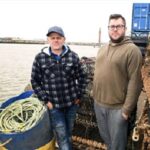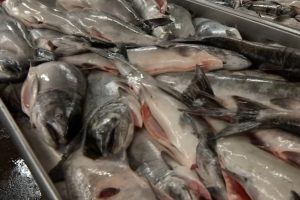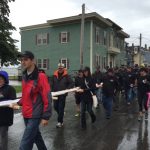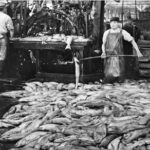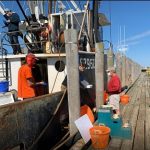Tag Archives: Fukushima
Fukushima sake brewer warms shattered Japanese fishing community
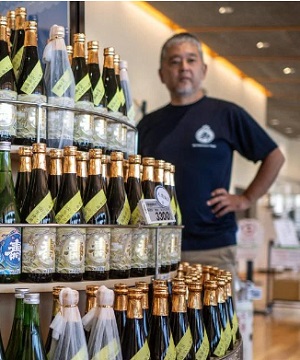 Daisuke Suzuki is helping by doing what he does best as life tentatively returns to normal for the devastated fishing communities of Japan’s Fukushima region: making sake. The “toji” sake master and his family were lucky to escape with their lives when a huge earthquake and tsunami devastated the area in March 2011, killing about 18,000 people and knocking out the nearby nuclear plant. In the town of Namie, the disaster obliterated the old port of Ukedo and its local fishing industry, as well as the Iwaki Kotobuki sake brewery that Suzuki’s family has owned for five generations. For two centuries, at least, it had made the rice wine that revived many a fisherman’s spirits after returning to port from the capricious Pacific Ocean with a hold brimming with fish. They would drink cups of Iwaki Kotobuki sake over white-meat sashimi of flounder and bass, delicacies from the Fukushima coast. “The sake was always there, just like the fish,” said one taciturn local fisherman, not wishing to be identified. “That is the way it has been here since my childhood.” Two years ago, the government gave the all-clear for the sale of fish from the Fukushima region to resume. The fisherman needed something to drink, and Suzuki then built a new sake plant back in Namie. >>click to read<< 15:42
Daisuke Suzuki is helping by doing what he does best as life tentatively returns to normal for the devastated fishing communities of Japan’s Fukushima region: making sake. The “toji” sake master and his family were lucky to escape with their lives when a huge earthquake and tsunami devastated the area in March 2011, killing about 18,000 people and knocking out the nearby nuclear plant. In the town of Namie, the disaster obliterated the old port of Ukedo and its local fishing industry, as well as the Iwaki Kotobuki sake brewery that Suzuki’s family has owned for five generations. For two centuries, at least, it had made the rice wine that revived many a fisherman’s spirits after returning to port from the capricious Pacific Ocean with a hold brimming with fish. They would drink cups of Iwaki Kotobuki sake over white-meat sashimi of flounder and bass, delicacies from the Fukushima coast. “The sake was always there, just like the fish,” said one taciturn local fisherman, not wishing to be identified. “That is the way it has been here since my childhood.” Two years ago, the government gave the all-clear for the sale of fish from the Fukushima region to resume. The fisherman needed something to drink, and Suzuki then built a new sake plant back in Namie. >>click to read<< 15:42
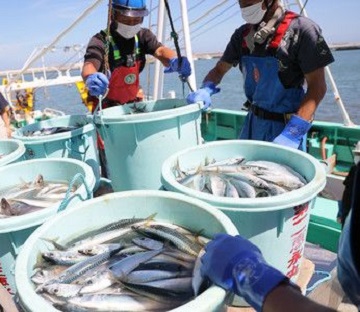
Trawl Fishing Resumes off Fukushima amid N-Plant Water Release
The offshore trawl fishing season kicked off in the northeastern Japan prefecture of Fukushima on Friday, about a week after the country began discharging treated wastewater from the Fukushima No. 1 nuclear power plant. Some 20 fishing vessels left Matsukawaura port in the city of Soma early in the morning. They began returning to the port from before noon for fish landings and auctions. “It’s regrettable we have to resume fishing while the treated water is being released, but I hope everyone will do their best,” Masahiro Kikuchi, vice head of the local Soma Futaba fisheries cooperative association, said at a departure ceremony held at the port from 1:30 a.m. >>click to read<< 12:18
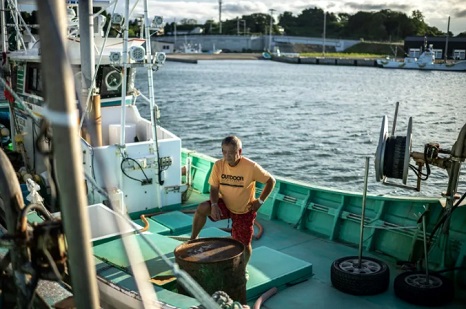
Water release finds little support in Fukushima
Most Fukushima fishermen are tight-lipped but Haruo Ono can’t keep his thoughts to himself on Japan’s plans to release treated cooling water from the stricken nearby nuclear power plant into the Pacific from Thursday. “Nothing about the water release is beneficial to us. There is no advantage for us. None. It’s all detrimental,” Ono, who lost his brother in the 2011 tsunami that crippled the plant, told AFP. “Fishermen are 100 percent against,” the 71-year-old said at his modest home in Shinchimachi, around 60 kilometres (40 miles) north of the nuclear plant in northeast Japan. “The sea is where we work. We make a living off of the sea, we’re at the mercy of the sea. So if we don’t protect the sea, who would?” >click to read< 07:43
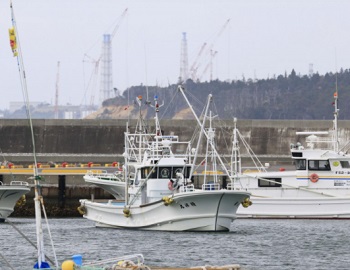
Japanese fishermen angered by gov’t decision on Fukushima plant water release
The controversial move came at “the worst time” for fishermen who are stepping up preparations for the restart of full-fledged coastal fishing off Fukushima Prefecture, northeastern Japan, after years of small-scale, trial fishing complete with safety checks for radioactive materials to win back consumer trust, ended in March. “Why now? I’m strongly opposed to the release (of treated water),” said Yoshimi Terashima, a fisherman from the Fukushima town of Shinchi. “I want to go fishing every day like I used to,” said the 73-year-old, who can do so only twice a week at present. >click to read< 09:10
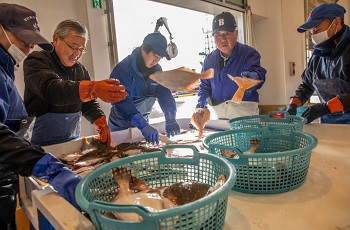
Eight years after Fukushima’s meltdown, the land is recovering, but public trust is not
Eight years after an earthquake, tsunami and one of the most severe nuclear accidents in history, the Japanese prefecture of Fukushima is getting back on its feet. Officials say the area’s fruits and vegetables are fine to eat. So is the catch from the Fukushima fishing boats. Radiation levels in the prefecture’s capital city, Fukushima, are comparable to the super-safe readings in places such as Hong Kong and London, monitors say. And a massive decontamination effort is still underway. But facts and spreadsheets supplied by the government are one thing. Rebuilding trust among locals may be significantly harder, thanks to a culture of coverups and denials that contributed to the nuclear accident and continues to dog Japan’s efforts to restart its nuclear industry,.. >click to read<21:22

Fukushima’s fishing industry stuck in slow but steady battle to change public perceptions after 3/11
Since the March 2011 nuclear crisis, fishery workers in Fukushima Prefecture have had the unprecedented and daunting task of convincing consumers that local fish are safe to eat. Fishing has resumed on a “trial” basis and the catches are gradually increasing. But seven years on, radiation checks are now part of their routine before shipping the fish to markets. Japan has a cuisine culture that is often synonymous with sushi overseas, and consumers value not just the safety but the freshness of seafood. >click to read< 13:14
Seven Years After Tsunami, Japanese Live Uneasily With Seawalls – When a massive earthquake struck in 2011, Japanese oyster fisherman Atsushi Fujita was working as usual by the sea. Soon after, a huge black wave slammed into his city and killed nearly 2,000 people.>click to read<
Japan’s Fukushima nuclear disaster didn’t affect fish, humans in B.C., scientist says
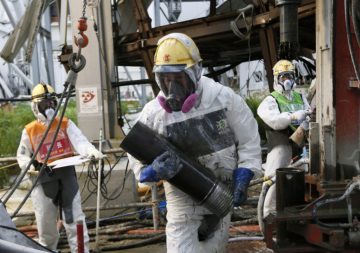 Radioactive contamination following a nuclear power-plant disaster in Japan never reached unsafe levels in the north Pacific Ocean for either marine life or human health, says a British Columbia scientist. Chemical oceanographer Jay Cullen of the University of Victoria has monitored levels of contamination from radioactive isotopes, used in cancer therapies and medical imaging, since the meltdown of three reactors at the Fukushima Daiichi plant in 2011 following a tsunami triggered by an earthquake. click here to read the story 18:29
Radioactive contamination following a nuclear power-plant disaster in Japan never reached unsafe levels in the north Pacific Ocean for either marine life or human health, says a British Columbia scientist. Chemical oceanographer Jay Cullen of the University of Victoria has monitored levels of contamination from radioactive isotopes, used in cancer therapies and medical imaging, since the meltdown of three reactors at the Fukushima Daiichi plant in 2011 following a tsunami triggered by an earthquake. click here to read the story 18:29
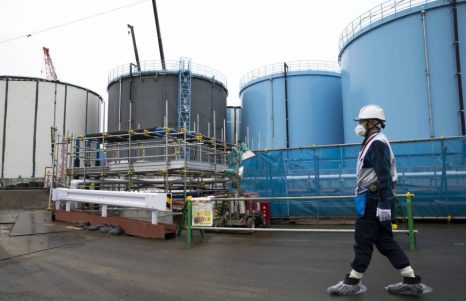
Fishermen Object – Fukushima’s tritiated water to be dumped into sea
Despite the objections of local fishermen, the tritium-tainted water stored at the Fukushima No. 1 nuclear plant will be dumped into the sea, a top official at Tokyo Electric says. “The decision has already been made,” Takashi Kawamura, chairman of Tokyo Electric Power Company Holdings Inc., said in a recent interview with the media. Tritium typically poses little risk to human health unless ingested in high amounts, and ocean discharges of diluted volumes of tritium-tainted water are a routine part of nuclear power plant operations. This is because it is a byproduct of nuclear operations but cannot be filtered out of water.,,, But fishermen who make their livelihoods from sea life near the plant are opposed to the releases because of how the potential ramifications will affect their lives. “Releasing (tritium) into the sea will create a new wave of unfounded rumors, making our efforts all for naught,” said Kanji Tachiya, head of a local fishermen cooperative. click here to read the story 13:24
For the third consecutive year, testing finds Alaska seafood free of Fukushima radiation
 The Alaska Department of Environmental Conservation said in a statement that seafood samples from Alaska waters in 2016 tested negative for three Fukushima-related radioactive isotopes: iodine-131, cesium-134 and cesium-137. The findings for the tested species – including king, chum, sockeye and pink salmon, as well as halibut, pollock, sablefish, herring and Pacific cod – matched those from 2014 and 2015. “Fish species were chosen for testing based on their importance to subsistence, sport, and commercial fisheries and because they spend part of their life cycle in the western Pacific Ocean,” DEC officials wrote. “Samples of fish were taken by DEC environmental health officers during regular inspections of commercial fishing processors throughout the state.” Department spokeswoman Marlena Brewer said that the samples were tested at DEC’s Environmental Health Laboratory in Anchorage, using portable gamma-ray analysis equipment provided by the U.S. Food and Drug Administration. Click here to read the rest 18:26
The Alaska Department of Environmental Conservation said in a statement that seafood samples from Alaska waters in 2016 tested negative for three Fukushima-related radioactive isotopes: iodine-131, cesium-134 and cesium-137. The findings for the tested species – including king, chum, sockeye and pink salmon, as well as halibut, pollock, sablefish, herring and Pacific cod – matched those from 2014 and 2015. “Fish species were chosen for testing based on their importance to subsistence, sport, and commercial fisheries and because they spend part of their life cycle in the western Pacific Ocean,” DEC officials wrote. “Samples of fish were taken by DEC environmental health officers during regular inspections of commercial fishing processors throughout the state.” Department spokeswoman Marlena Brewer said that the samples were tested at DEC’s Environmental Health Laboratory in Anchorage, using portable gamma-ray analysis equipment provided by the U.S. Food and Drug Administration. Click here to read the rest 18:26
Fukushima radiation has reached U.S. shores – Poses no danger to humans or the environment, they say.
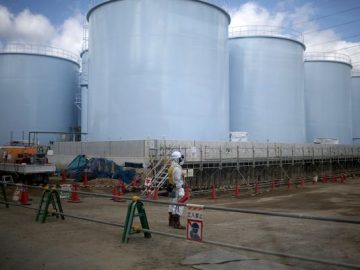 For the first time, seaborne radiation from Japan’s Fukushima nuclear disaster has been detected on the West Coast of the United States. Cesium-134, the so-called fingerprint of Fukushima, was measured in seawater samples taken from Tillamook Bay and Gold Beach in Oregon, researchers from the Woods Hole Oceanographic Institution are reporting. Because of its short half-life, cesium-134 can only have come from Fukushima. Also for the first time, cesium-134 has been detected in a Canadian salmon, the Fukushima InFORM project, led by University of Victoria chemical oceanographer Jay Cullen, is reporting. In both cases, levels are extremely low, the researchers said, and don’t pose a danger to humans or the environment. Read the rest here 16:53
For the first time, seaborne radiation from Japan’s Fukushima nuclear disaster has been detected on the West Coast of the United States. Cesium-134, the so-called fingerprint of Fukushima, was measured in seawater samples taken from Tillamook Bay and Gold Beach in Oregon, researchers from the Woods Hole Oceanographic Institution are reporting. Because of its short half-life, cesium-134 can only have come from Fukushima. Also for the first time, cesium-134 has been detected in a Canadian salmon, the Fukushima InFORM project, led by University of Victoria chemical oceanographer Jay Cullen, is reporting. In both cases, levels are extremely low, the researchers said, and don’t pose a danger to humans or the environment. Read the rest here 16:53
Five Years After Fukushima, Ocean Radiation Poses Little Risk to U.S.
 March 11 marks the fifth anniversary of the Fukushima Daichi nuclear power plant explosion in Japan. More than 80 percent of the radioactive material from the explosion leaked into the Pacific Ocean, released via groundwater. Dr. Ken Buesseler, an oceanographer, has spent the five years since Fukushima investigating the effects of the disaster on ocean radioactivity, through research funded by the Woods Hole Oceanographic Institution. He and his team have also sampled water near the West Coast to see if the effects of the disaster have been felt in the U.S. Read the rest here 07:51
March 11 marks the fifth anniversary of the Fukushima Daichi nuclear power plant explosion in Japan. More than 80 percent of the radioactive material from the explosion leaked into the Pacific Ocean, released via groundwater. Dr. Ken Buesseler, an oceanographer, has spent the five years since Fukushima investigating the effects of the disaster on ocean radioactivity, through research funded by the Woods Hole Oceanographic Institution. He and his team have also sampled water near the West Coast to see if the effects of the disaster have been felt in the U.S. Read the rest here 07:51
Radiation from Fukushima nuclear disaster not found in B.C. salmon
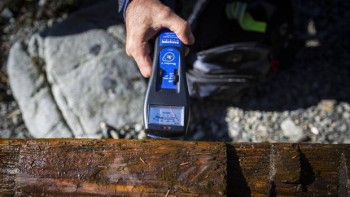 Five years after the Fukushima nuclear accident in Japan, radioactive contaminants continue to circulate across the Pacific to Canada’s West Coast, but not at dangerous levels. A B.C. scientist monitoring fish for tell-tale traces of cesium-134 said the radionuclide, which is the fingerprint of the Fukushima disaster, has been found in seawater but not in recent samples taken from 156 salmon. Steelhead, Chinook, sockeye and pink salmon were collected by First Nations from locations spread along the B.C. coast last year as part of an ongoing monitoring program. In releasing the latest test results, Jay Cullen, with the ,,, Read the rest here 13:37
Five years after the Fukushima nuclear accident in Japan, radioactive contaminants continue to circulate across the Pacific to Canada’s West Coast, but not at dangerous levels. A B.C. scientist monitoring fish for tell-tale traces of cesium-134 said the radionuclide, which is the fingerprint of the Fukushima disaster, has been found in seawater but not in recent samples taken from 156 salmon. Steelhead, Chinook, sockeye and pink salmon were collected by First Nations from locations spread along the B.C. coast last year as part of an ongoing monitoring program. In releasing the latest test results, Jay Cullen, with the ,,, Read the rest here 13:37
Salmon fishing returns to Fukushima after 5-year absence
 Traditional salmon “combination net fishing” returned to the Kidogawa river here for the first time in five years as fishermen hauled in about 120 of the cold-water fish. With the evacuation order for Naraha lifted in September, members of the local fisheries cooperative association gathered around 11:30 a.m. on Oct. 18 to drive salmon from the upper reaches of the Kidogawa with a net toward another one set up downstream. It was the first time the fishing operations took place since,,, Read the rest here 09:21
Traditional salmon “combination net fishing” returned to the Kidogawa river here for the first time in five years as fishermen hauled in about 120 of the cold-water fish. With the evacuation order for Naraha lifted in September, members of the local fisheries cooperative association gathered around 11:30 a.m. on Oct. 18 to drive salmon from the upper reaches of the Kidogawa with a net toward another one set up downstream. It was the first time the fishing operations took place since,,, Read the rest here 09:21
Update: No Fukushima Contamination Detected in Pacific Salmon Off North American Coast
 The Integrated Fukushima Ocean Radionuclide Monitoring (InFORM) project is a network involving academic, governmental, and non-governmental organizations, as well as citizen scientists. InFORM is acquiring data to support a thorough radiological impact assessment for Canada’s west coast stemming from the Fukushima Dai-ichi nuclear power plant (FD-NPP) accident, and to effectively communicate these results to the public. Read the rest here 16:00
The Integrated Fukushima Ocean Radionuclide Monitoring (InFORM) project is a network involving academic, governmental, and non-governmental organizations, as well as citizen scientists. InFORM is acquiring data to support a thorough radiological impact assessment for Canada’s west coast stemming from the Fukushima Dai-ichi nuclear power plant (FD-NPP) accident, and to effectively communicate these results to the public. Read the rest here 16:00
Japanese reactor radiation detected off Vancouver Island, B.C.
 University of Victoria chemical oceanographer Jay Cullen said Monday that it’s the first time radiation has been found on the shorelines of North America since the quake and tsunami ravaged the Japanese north coast and disabled the nuclear reactor. “We’re more than a thousand-fold below even the drinking water standard in the coastal waters being sampled at this point. Those levels are much, much, much lower than what’s allowable in our drinking water.” Read the rest here 15:28
University of Victoria chemical oceanographer Jay Cullen said Monday that it’s the first time radiation has been found on the shorelines of North America since the quake and tsunami ravaged the Japanese north coast and disabled the nuclear reactor. “We’re more than a thousand-fold below even the drinking water standard in the coastal waters being sampled at this point. Those levels are much, much, much lower than what’s allowable in our drinking water.” Read the rest here 15:28
Fukushima nuclear pollution hasn’t hit B.C. shore, says researcher Jay Cullen
 Four years after a massive earthquake struck Japan, creating a nuclear disaster in Fukushima, research shows nuclear pollution is making its way towards B.C., but isn’t affecting fish. “According to all the measurements that we’ve made thus far, and with our partner Health Canada who have been making measurements of fish since 2011, we’ve yet to detect that marker isotope for fish caught along the coast,” Jay Cullen, a University of Victoria professor, told Daybreak North’s Carolina de Ryk. Read the rest here 11:16
Four years after a massive earthquake struck Japan, creating a nuclear disaster in Fukushima, research shows nuclear pollution is making its way towards B.C., but isn’t affecting fish. “According to all the measurements that we’ve made thus far, and with our partner Health Canada who have been making measurements of fish since 2011, we’ve yet to detect that marker isotope for fish caught along the coast,” Jay Cullen, a University of Victoria professor, told Daybreak North’s Carolina de Ryk. Read the rest here 11:16
Canadian scientists find Fukushima fallout rising off West Coast
 Radioactivity from Japan’s crippled nuclear reactors has turned up off the British Columbia coast and the level will likely peak in waters off North America in the next year or two, says a Canadian-led team that’s intercepted the nuclear plume. The radioactivity “does not represent a threat to human health or the environment,” but is detectable off Canada’s west coast and is climbing, a team led by oceanographer John Smith at reported Monday in the Proceedings of the National Academy of Sciences. Read the rest here 11:02
Radioactivity from Japan’s crippled nuclear reactors has turned up off the British Columbia coast and the level will likely peak in waters off North America in the next year or two, says a Canadian-led team that’s intercepted the nuclear plume. The radioactivity “does not represent a threat to human health or the environment,” but is detectable off Canada’s west coast and is climbing, a team led by oceanographer John Smith at reported Monday in the Proceedings of the National Academy of Sciences. Read the rest here 11:02
Alaska Fish Said to be Unaffected by Fukushima Accident
Any concerns of radiation from the Fukushima explosion in 2011 affecting the Alaskan seafood has been ruled out by the US Food and Drug Administration. Listen, and read more here 14:37






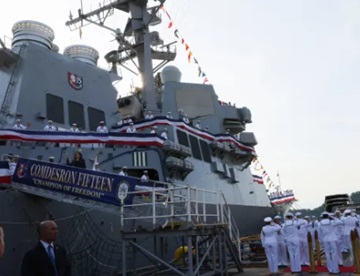
 Following the devastating 2011 earthquake and tsunami in Japan, there have been public concerns about potential impacts on Alaska seafood from the Fukushima nuclear disaster. Although modeling and other analyses have not demonstrated a potential risk to Alaska fish, the Alaska Department of Environmental Conservation (DEC) Division of Environmental Health (DEH) has been coordinating with the Department of Health and Social Services (DHSS) Division of Public Health, as well as other state, federal, and international agencies and organizations to address continued public concerns.
Following the devastating 2011 earthquake and tsunami in Japan, there have been public concerns about potential impacts on Alaska seafood from the Fukushima nuclear disaster. Although modeling and other analyses have not demonstrated a potential risk to Alaska fish, the Alaska Department of Environmental Conservation (DEC) Division of Environmental Health (DEH) has been coordinating with the Department of Health and Social Services (DHSS) Division of Public Health, as well as other state, federal, and international agencies and organizations to address continued public concerns. 


























